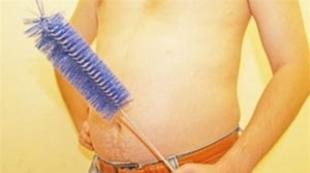Installing an acrylic bath on bricks. Installing a bathtub on bricks: why do it and how to install it correctly
I'll tell you how I brick an ordinary metal bath. Before us is a metal bathtub, there are legs in the kit. The task is to install a bathtub so that even a hundred-kilogram person would jump into it from acceleration, but it would not move.
For my customers, I recommend reinforcing the bathtub with an additional brick wall. It is done like this: Before installing to the wall, we fasten the legs, fasten the siphon (the legs and siphons are different, so I won’t dwell on this, the question is different), we prepare the metal bath for foaming (the foam reduces the noise of pouring water, plus the metal bath holds better warmly).
We screwed it up, now we turn the bath over and carefully wipe the surface with a rag (this is enough, it is not necessary to degrease). Then we apply foam to the surface of the bath, foam everything except the front side, in this place we will have a brick wall. A 1.70-ton tub will take three large tubes of foam.
Leave for half a day, wait until the foam dries. The foam has dried, we attach the bath to the wall, set it according to the level (we catch zero, we catch zero with legs, they usually have threaded studs, they are adjustable, at the end we fix the studs with nuts and lock nuts). Many people think that the back of the tub needs to be raised to best drain, but it's not. The manufacturer decided everything for us, a slope has already been made at the bottom of the bathroom, the bath should be at zero.
The line on the floor will be our guide, from it (from the line) we retreat another couple of centimeters (these centimeters are needed for tiles plus glue). We put the first bricks, put them on the edge. Naturally, the brick is placed in a run.
After a couple of minutes of work, we understand that the higher, the more problematic, a whole brick no longer fit. The sides of the baths can be of different widths, but a whole brick will still not rise above three rows. We also do not forget that the tile should lie a couple of millimeters deeper than the side of the bathroom, so it will be easier for a person taking a bath to get up, there is something to catch on, a flush tile is a less convenient option.
Well, above the bricks that are wider, I just plaster, I use pieces of brick as "ballast" (we buy brick with slots, this one is better suited for this work).
If the bath is shorter than the wall (and this is a common occurrence), then we fill the void with the same brick, we don’t reach the edge, about two centimeters, we leave room for the tile, we get an additional shelf, we put the tile on this “shelf” with a slight slope so that the water flowed into the bath.
In general, everything remains, in the masonry, to mount a plumbing door, you can build a frame for it, or you can get by with a brick. We install a sanitary door in the siphon area, through it you can not only clean the siphon, but even replace it.
The bath is installed "dead", in a couple of days you can jump in it. It has been checked dozens of times, I often work from the side of such a bathtub, I work on the ceiling (lining, drywall, and so on), my weight is a centner, the bathtub can easily withstand it.
Well, in the end, I’ll add, some people think that the solution harms the metal, but these are all fairy tales, the inner surface, metal baths, it is painted and it is not afraid of the solution, I contemplated the fruits of my work and ten years after its completion, everything is fine, the bath will stand the same amount, the house will fall into disrepair earlier.
It takes me half an hour to make this wall, the frame cannot be built in such a time, and it will not strengthen the bath, I only make frames on cast iron.
A bathtub installed on ordinary legs is not able to withstand a heavy structure for a long time. And after a couple of years, the screw mount will begin to loosen and lose its functionality.
Therefore, the choice of many falls on the strongest supports from brick luggage. The contact zone with such an installation is much larger, therefore it is attached much better. How to properly install a bath on bricks, and what is important to know, we will consider in the article.

This is where you need to start when thinking about changing your bathroom. It is necessary to think over actions that will be useful in the future at the level of finishing work.
The floor must be level. Waterproof in advance. When tiling, use a quality cement mortar, tile adhesive. If you use highly diluted low-quality glue, there will be voids between the tiles and the floor.
Don't use this method. Big weight bricks will crush, which will lead to cracks, breaks in the tiles. Tiling should follow after installing large plumbing fixtures. Those. to begin with, a sink, bathtub, etc. are placed, and then it is already lined.
If you do everything right, the bath, especially enameled, will last a very long time.
Proper installation of the bath on bricks with your own hands will cause a long service life.

Why put a bath on bricks
This design has been a success for a very long time. There are several reasons for this:
- Reliable way;
- Possesses greater fastening strength;
- sustainability;
- Long service life.
When buying a bathroom, legs are additionally included for its installation. But as practice shows, it is less reliable than bricklaying. After 10 years of installation on the native legs of the bath, they begin to deform, as a result of which the bath itself changes. Due to these changes, water may not drain completely into the sewer.
Well, if there are overweight people in the family, the period of use of the legs is even less. Confidence for a long service in this case rests only on brick luggage. Typically, native mounts are made of metal. Due to excess moisture in the bathroom, they will quickly rust, lose their appearance and functionality.
Necessary materials for installing a bathroom on bricks
For correct installation there is no need to buy expensive tools and materials. Everyone has this set in their garage. Well, materials can be purchased at a reasonable price in hardware stores, furniture stores. Necessary:
- Ceramite (brick), from 15 pieces.
- Everything you need for cement mortar.
- Sealant.
- Metallic profile;
- Bulgarian;
- self-tapping screws;
- Level ruler;
- Master OK;
- Rubber gaskets for waterproofing.
Take tape sealant. It well isolates the seams, facilitates the work. Hollow bricks are not used in this case. Buy red, white.
Don't buy spacers unless you have a steel tub. And if steel, install as many bricks as possible. It weighs little, so it is easier to loosen it. The level is also very important. It will help to put the bath more evenly.
We carry out measurements for installing a bathroom
It is important to use correctly measuring instruments clearly measure, mark the place for the bath. This should be done only after its acquisition, because. We need precise measurements, not approximate ones. Also, measurements must be taken not only before installation, but also during it.
The first step is to make the right measurements. Use a tape measure or measuring tape. We need parameters for width, length, depth. If the depth in several parts of the bath is different, measure it several times. You also need to measure the place from the ends to the brick supports. Your bathroom can be of different lengths, but with a standard approach, the distance between bricks should be about 50 cm.
For best result you need to check if the measurements are correct. To do this, you need to find out the length of the bath, measure 25 cm in different directions. Under these places, in the future, brick luggage should be installed. It is also useful to measure the distance from the drain of water into the sewer, to the very bottom.

It is important to choose the right place. The tub should be in very close contact with the wall. If you make such a mistake, all the water will drain to the floor through the gaps. After a couple of months, mold will begin to form. This is very harmful to both the condition of the house and its inhabitants.
But it should adjoin only to two walls. If the room is small, make sure that the ends of the bath do not touch the third or fourth wall. The bath may overheat, due to deformation. After installation with full contact with the first two walls, fill the joint with sealant. Before installing, think about the height of the tub from the floor. Approximate height - 1 brick.
The number of bricks needed for luggage is not difficult to count. They buy an average of more than 15. They need two props. 2.5 bricks go to the width of the bath, and the height is at the request of the owner.
In order for the water to completely pour into the sewer, the side of the drain hole is made slightly lower than the second. Experts recommend using numbers: 17 cm in height on the side with a hole and 19 on the side without it. But people began to make bathtubs designed so that the water quickly drains. For such baths, you should not make a difference in the height of the racks. For markings, transfer all the parameters of the bath in advance with a pencil to the walls and floor.

Installation of bath supports
After completing all the preparatory work, having dealt with necessary materials After checking all the calculations, you can proceed with the installation.
First you need to do sandy cement mortar. Ratio 1:4 (more sand).
According to the first work, only on one load. We lay the first row, wait for the solution to solidify, with the help of the level we correct everything. The bath can be kept on one level, but you can also lay the second and third. After the cement has dried at all levels, on the outer sides of the supports, report another half of the brick. It will look better. After a day, everything will completely freeze.
Immediately after drying, you can not install a bath. First you need to install a siphon. It is necessary to turn the bath on any side, and seal all holes in the bath (except for the large and main one) with hermetic means. After installing the siphon with overflow. Only then can you put the bath on brick luggage.
Important! Install so that sewage pipe was below the siphon.
Installing a bathtub, how to install a bathtub on a brick
If you have a steel tub, lay the gaskets before installation. Usually one person cannot cope with the installation, ask 1-2 people for help. Carefully place a level on the bottom of the tub.
Then grab it from different sides, lift it up and lower it onto the bricks. Don't forget about bathtubs, which may already be adapted to a favorable drain. The level is only used when classic version. This is when the bottom is parallel to the floor.
Well, if the bath is inside with slopes, then using the level, the correct location is marked with outside. Do all the work slowly, do not rush anywhere. Do not forget about the snug fit of the bath to the wall. Discuss every action with your partner.
Next, you need to check the strength and durability. Grab onto any edge of the tub. After gently try to take aside. It's like you're trying to turn it around. If it moves a little, errors were made during installation. Understand the problem, carefully inspect the entire structure. Maybe somewhere you need to put another brick, or use better and more mortar and sealant.
Rigid fixation and pipe installation
If the bath is made of steel, it is very light. She has great instability. Additional supports are added to fix the problem. Usually piers and brick luggage are used as a stand. Bricks are placed under each corner of the bath.
But how do you know which method to solve the problem? Use the rack or do the construction of the wall? This problem is easily solved. If the bath is tightly pressed with only one side to the walls, use the walls. Well, if the bath is in the corner between the walls, or pressed against three, it is more stable. This is where bricks can help.
The bath can be installed in several ways: on legs, on metal carcass, on bricks. Today we will consider the most reliable and high-quality of them, which meets the requirements for strength and stability - installing a bathtub on bricks.
Installing a bathtub on bricks has been a success for many years. This technology, according to experts, helps to set the bathtub quickly and efficiently to the desired level, rest it on a solid foundation and achieve durability of the supporting part. Naturally, you can not waste time and money and install the bathtub on the standard legs that come with the kit, but only they will not last very long in their original state - after 10-12 years the legs can bend a little, rust and deteriorate, and this is fraught some negative consequences. For example, a bathtub can sag on its legs and the desired slope will be lost, as a result, the water will not completely drain into the sewer. Also, due to defects in the legs, the bathtub can change its height, which means that a gap is quickly formed between the bathtub and the finish, where moisture will enter. Such moments, as well as the ability to set the bathtub securely and really stable, incline us to the decision to install the bathtub on bricks.
What is needed to install a bath on bricks?
Installing a bathtub on such a support is not difficult, and therefore, you do not need professional tools and expensive building materials. In fact, the following will suffice: bricks, cement mortar, tape sealant, metal profile, mixing tank, trowel, level, hammer, perforator, grinder, self-tapping screws and maybe a few more little things.

First of all, this is preparatory work, during which you will need to correctly mark and calculate everything. You can start with the size of the bath that you will purchase and install. They need to be determined very precisely, and transferred in the form of markings to the bathroom. Thus, you will know exactly where and in what position the bath will be installed, how wide and long it will be, where to supply water, sewage, and so on. But, this only applies to preparatory work during the complete renovation of the bathroom, as well as the preparation of design projects. If the renovation in the bathroom has already been done, and you just want to change the bath, the main thing is to guess with the dimensions and markings.
Now, you need to bring the bath into the bathroom and mark the base, that is, where exactly the brick bases will be installed. They can be placed closer to the center or closer to the edges of the curve of the bath, which is more correct, since the wide brick base can provide good stability. When you mark the place for laying the base, proceed to kneading the mortar.
You will need a little cement mortar, since no more than two dozen bricks will go into the masonry. Make it the right consistency, so you can complete the masonry within an hour. After the solution is ready, you can proceed directly to the masonry.

Installation cast iron bath on bricks, installation steel bath on bricks and installing an acrylic bath on bricks is completely the same, and therefore you should not re-read several materials and choose a better and faster way. The main thing here is to do everything right.
The laying should be done as follows: the base under the back - at a height of 19 cm, the base under the front - at a height of 17 cm. This is necessary in order to ensure the correct flow of water from the bathroom. But be careful, because many modern baths already provide for a certain slope angle of the bottom of the drain bath, and therefore, in this case, the bath will need to be installed under the level along the top.
After the masonry is ready, you can install the bath. It would be best to use this moment tape sealant, as it can provide a good joint and stability of the bath on bricks. You can use the popular Guerlain, which is used by most masters.
The bathtub on a brick base should be installed slowly, evenly, pushing tightly against the walls, until it stops. Further, the bathtub on bricks can be additionally fixed to the wall using a metal profile, self-tapping screws and dowels. It is rarely used, but it does happen.

After the bath is installed and checked for strength and stability, you can start connecting the sewer, faucet, screen installation and laying the baseboard on the bath.
A bath has long been an indispensable attribute of every home, but until now, modern shower cabins do not reach the level of comfort and convenience of this traditional plumbing fixture. To guarantee reliability, stability, long service life, you need to take care of the quality installation of the font, especially if this operation is done by yourself.
There are several installation methods, the simplest of which is the installation of a bath on bricks. The brick base evenly distributes the weight and load exerted on the flooring. In this article we will tell you how to make supports yourself and fix the bath on them.
Advantages of the method
Installing bathtubs using brick supports is a reliable method of fixing a steel, acrylic or cast-iron font that you can do yourself. For the manufacture of "legs" from this, only red solid brick is used, which can withstand intense weight loads, exposure to water and harmful microflora.

Despite the fact that each bath is equipped with standard metal legs, craftsmen install plumbing fixtures on a brick base, as it distributes the load more evenly and provides greater stability. This installation method has the following advantages:
- Sustainability. When mounting containers for washing on a brick base, greater stability is achieved, this indicator is especially important when installing light weight steel and acrylic products. Models made of these materials with poor-quality fixation sway, stagger, slide, which adversely affects the safety of use.
- Prevention of wall deformation. The use of a solid base for mounting, supporting the bottom, prevents deformation of the walls of the product, so that the enamel lasts longer. The fact is that the walls of thin-walled models are deformed under the influence of weight loads, causing the enamel coating to crack and peel off. In addition, this installation method reduces the filling noise associated with metal tubs.
- Versatility. With the help of brick legs, all types of baths are installed, regardless of weight, shape or size. In addition, this method allows you to easily raise the font to any height.
Note! Do-it-yourself installation of a font on bricks is more expensive than installation using standard legs supplied in the kit. The cost of work consists of the cost of bricks and the cement-sand mixture used to prepare the mortar. The least material is required to make brick posts, but this method is not much more efficient than the standard one.
Ways
Red brick - universal construction material, with the help of which supports are made for all types of bathtubs. Depending on the weight, shape and type of product, the installation method is selected. There are the following types of brick supports for fonts:

Important! High-quality installation of a bathtub on bricks minimizes the disadvantages of inexpensive, thin-walled models that are not of high quality. Due to stable and reliable fixation, the product will last longer, since its walls are not deformed during operation. In addition, during installation on a brick base, you can reduce the noise and thermal conductivity of metal models by isolating the bottom with mounting foam.
Installation technology
You can easily install a plumbing fixture made of cast iron, steel or acrylic with your own hands. Before installing the bath on bricks, you need to level and tile the floor, but it is better to wait with the wall decoration. To work, you will need a brick, a moisture-resistant mortar, mounting foam and a building level. The installation technology on a brick base is as follows:

Please note that the joints between the sides of the bathtub and the walls must be waterproofed with sealant or other methods. If the gap between them is more than 1 cm, then it is better to use a moisture-resistant solution for embedding.
Video instruction
The correct installation of the bath begins with the search for 15 red bricks, on which it will subsequently stand. The thing is that on the standard legs that come with the kit, you will never get the perfect installation of the bath. Standard legs are usually made of the same cast iron as the tub, or if the tub is made of iron, and are connected to the tub with screws.
Such a connection under changing loads is very unreliable and cannot ensure complete immobility of the bath during operation. This immobility of the bath, especially for a long time, will help to avoid the appearance of cracks at the junction of the bath to the walls, which, in addition to the flow of water behind the bath, can, due to the extremely long drying time of the water, lead to the formation of mold. In general, to eliminate the root causes of the reeling of the bath, they install the bath on bricks.

Brick racks must be of a certain height, which is necessary so that after installing the bath, its upper part is at a height of 60 cm from the floor. Approximate height of brick racks: front - 17 cm, second - 19 cm from the level of the finished floor, while if the protruding fastening parts of the bath get on the racks, they can be cut down or the height of the racks can be reduced. Instead of mortar for laying bricks, it is better to use tile adhesive, which will make the seams thinner, and the increased adhesion of the adhesive will make the entire masonry racks more solid. Some bathtubs also have different depths and it is advisable to measure the depth of the bathtub and adjust the height of the racks accordingly before performing work.

The distance between the racks is determined by the length of the bath and averages 50-60 cm. This arrangement of brick racks is optimal if you are going to leave one or two niches for legs and basins under the bath. When planning in the future, completely close the bath with a screen, the dimensions between the racks of great importance they don’t play, and to increase reliability, you can make three instead of two racks.


Such a third support is obligatory on wide and long steel baths, whose thin iron will sag under your weight and the weight of the poured water. If you wish to leave open niches for basins on such large bathrooms, instead of the third brick support, you can use a solid support lying on the extreme ones. As such a support, welded end-to-end steel pipes, which will create an almost inflexible platform due to the formation of a large number of stiffeners.










